One of the many projects launched to herald Hull’s year as UK City of Culture was a celebration of its most famous daughter: the pioneering aviator Amy Johnson. But 76 years after her death – which was marked last year with a major festival – female pilots remain a rarity; worldwide just 3% of pilots are women, in the UK the figure is 6%. “The proportion is very slowly coming up but it is still miniscule,” says Marion Wooldridge, deputy chair of the British Women Pilots’ Association (BWPA).
The Guardian’s product and service reviews are independent and are in no way influenced by any advertiser or commercial initiative. We will earn a commission from the retailer if you buy something through an affiliate link. Learn more.
The BWPA has 300 members and has been supporting female pilots for more than 60 years. It grew out of the Air Transport Auxiliary, the second world war pilots who were deemed unfit for combat but remained vital to the war effort in ferrying aircraft around the country. A considerable number of them were women, most notably Johnson, who died in 1941 while ferrying a plane. However, it is only recently that the association has started to work with schools and careers offices to help enthuse girls about Stem subjects (science, technology, engineering and mathematics) – and a potential career as a pilot.

“Stem subjects aren’t essential to become a pilot but they are very useful, and one issue is the sense that these aren’t girls’ subjects. I’ve heard that girls are still being told it is not really something they do,” says Wooldridge, who believes a lack of female pilot role models is another major hurdle. “Once we saw the same with doctors and veterinary surgeons but now more women than men train in those professions.”
It costs about £100,000 to train and my feeling is that parents are more prepared to support male children than female
Good - and equal - pay, flexibility, variety, challenge and travel are just some of the benefits of the job cited by women pilots. Yet research by British Airways shows how few women consider a career as an airline pilot. In a poll of 2,000 women conducted by the airline in 2014, 63% said they were put off when they were growing up for reasons including a lack of visible role models and being told it was a man’s job. These findings are borne out by the pilots we spoke to. Sabeena Yosuf, a captain for BMI, said her careers advisor told her to think about something else when she said she wanted to be a pilot. Easyjet captain Marnie Irwin-Munns had a similar experience at school. More worrying is how pervasive the idea that girls can’t be pilots still is. “I went to give a talk at a school and the teacher said ‘oh the boys will love this.’ I said ‘the girls will too!’” said Irwin-Munns.
The cost of training may be another factor putting off women. “It costs about £100,000 to train and my feeling is that parents are more prepared to support male children rather than female children. It’s just a feeling,” says Wooldridge who has been a private pilot for 25 years. This year the BWPA is offering seven scholarships to women who want to train as pilots, which will help alleviate the financial burden a little.
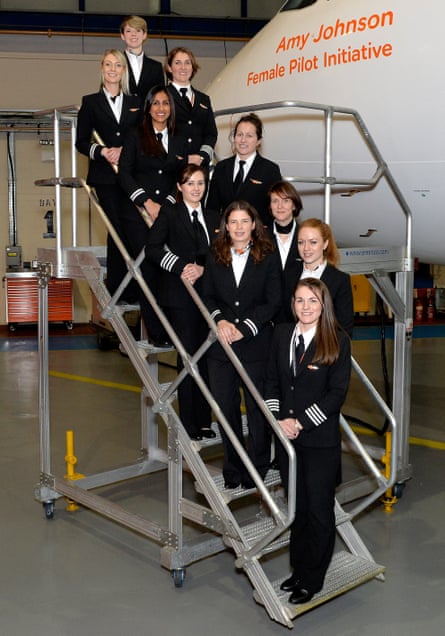
Airlines are also starting to introduce measures to attract more female applicants. Easyjet launched its Amy Johnson initiative in 2015 with the aim of doubling its new-entrant intake of women from 6% to 12%. After reaching that target in the first year it has a new goal of increasing that figure to 20% – or around 50 pilots a year – by 2020. Every year six of those new recruits will have their loan underwritten by the airline. British Airways launched a campaign in 2014 to increase the visibility of women pilots by visiting schools and recruitment events. BA employs 220 female pilots out of total 3,800 and recruited a record 350 pilots in 2016 under its Future Pilots Scheme. Virgin Atlantic’s Future Flyers Programme was launched with the aim of attracting recruits from more diverse backgrounds and more women. Of the 12 recruited onto this year’s programme, four are women. Other UK carriers, including BMI, Monarch and Jet2, recognise that applicants are overwhelmingly male but do not have any scheme in place to increase the numbers. Ryanair would not answer our questions.
So progress is hardly jet-paced. But Wooldridge is optimistic that the success of easyJet’s scheme will encourage similar initiatives. Perhaps by the time Hull puts on events for the 100th anniversary of Amy Johnson’s death in 2041 female pilots will no longer be so few in number. To celebrate those already in the air, Guardian Travel interviewed five female pilots about the ups and downs of their roles.
Katie Withers, captain, Monarch

As far as I can remember, I’ve always wanted to fly. My dad’s interest in aviation played a part: he had flying lessons when I was young, and used to take me to see air shows and visit air museums. I was hooked.
I joined the Air Training Corps at 13, and then the East Midlands Universities Air Squadron while studying at Nottingham. I considered a career in the RAF but decided I’d probably prefer the lifestyle of commercial flying. However, I lost my focus at this point as I wasn’t sure of the best route to becoming an airline pilot. I suppose I told myself that flying was just a pipe dream and that I’d probably end up doing something else.
Even now, a few years on, I sometimes have to pinch myself when I’m driving into work
I studied law, and then fell into accountancy, joining a graduate training programme. I hated this from day one, but my sensible side told me to stick with it. I started flying lessons at a local airfield, Wellesbourne, but this only made matters worse, when I realised how miserable I was in accountancy, and that flying as a hobby wasn’t enough. I remember one particular instructor who was a retired airline pilot: his inspiration – and the encouragement of my parents – gave me the courage I needed to pursue the dream.
I applied to CTC Aviation, a well-established training school that offered to take people from zero hours all the way through to sitting in the right-hand seat of a commercial jet. I was offered a course to head out to New Zealand (where they conducted the basic training) in December 2007. I handed in my notice and I haven’t looked back since. Even now, a few years on, I sometimes have to pinch myself when I’m driving into work. I see fantastic sights, from flying over the snow-capped Alps, to shooting stars at night, or watching lightning flash within a storm cell nearby.
The technical skills of flying the aircraft are just one aspect of the job. There is a lot of multitasking, and the softer skills of people management, communication and organisation, which are, arguably, more traditionally female strengths. There are countless decisions to be made throughout the day, and as pilots we must oversee the whole operation, keeping safety, legal and commercial issues in mind. Anyone who thinks flying is just button-pressing in an office with a nice view is mistaken.
Marnie Irwin-Munns, 41, captain, easyJet

I started flying in 1994 with the university air squadron. Set up by the RAF, it recruits and trains people with a view to joining the air force. I put in two years of 100 hours flying, in two-seater aircraft, and did that alongside my psychology degree. However, it was flying that interested me, rather than the air force, and so I joined a flying scheme with Aer Lingus and got my commercial licence. I was one of two women in the scheme.
6% [of female pilots] is not acceptable
Working for easyJet I was approached to launch the Amy Johnson initiative. We are in the process of creating easyJet ambassadors who will go into schools and talk about what we do. A lot of it is about visibility; it’s about talking to girls and saying, “You can do this too.” When I said I wanted to be a pilot my careers adviser said: “Well, what else do you want to do?” We have a similar lifestyle to cabin crew but no one questions that! But 6% [of female pilots] is not acceptable. Women may not be as interested but I can’t believe it’s really as low as that. It’s a societal thing.
Science skills are important but you need a logical mind that works well under pressure, and to be good at multitasking. I love the fact that you go to work and it’s always different, always a challenge. Also, it never ceases to amaze me how beautiful it is; I feel the excitement seeing the mountains as I fly into Geneva, even though I’m not going skiing. Faro is another place where we get a spectacular view, especially when the sun is setting.
Helen McNamara, 40, senior first officer, British Airways
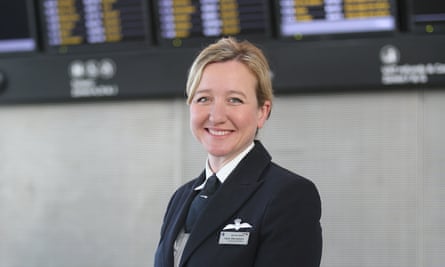
My first experience of flying was actually when I went backpacking as a student in Africa and took a flight over Victoria Falls. The pilot let us hold the controls and I liked the technical side of it. I wanted to get into flying and undertook private pilot’s licence training at Leeds Bradford airport. I didn’t know anyone in aviation at that point but I heard about a sponsorship programme at BA. There were about seven of us [women] on that. I began in 1998 and started flying in 2000, doing European flights on a 737 out of Gatwick; after five years I changed to flying 767s on both long-haul and short-haul flights.
There are a lot of advantages to aviation as a career because of the equality with which we are trained and paid
There are a lot of advantages to aviation as a long-term career because of its flexibility and the equality with which we are trained and paid. Unlike a lot of careers the pay scale is transparent: we are paid the same as men. It’s also very accommodating with flexible working patterns. I normally fly about four days a week.
One of the most important attributes is interpersonal skills. You’re not flying a single-seater aeroplane: you’re flying with a crew of 20 or more, plus hundreds of passengers. When you meet people for the first time and have to work with them you only have a short period of time to gel together as a team.
My favourite European destination is Rome. There’s a popular coffee shop there, Sant’Eustachio, and I always go to it. One of our Italian cabin crew recommended it. It makes coffee behind a screen; it’s totally secret! I normally drink black coffee but this is the only place in the world where I drink it white.
Sabeena Yousuf, 35, captain, BMI Regional
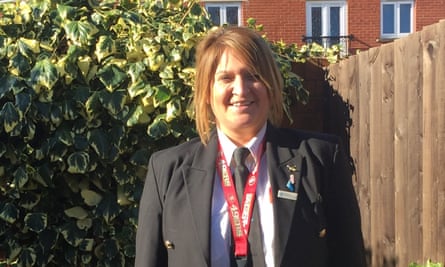
When I was younger, I used to travel to Pakistan and America with my family and I liked the idea of pilots and cabin crew going on holiday every week! But [at school] when I told my careers adviser what I wanted to do and that I’d looked into it she told me to change my mind. I told my mum and she said, “Do whatever you want to do.”
I think women are better [at flying] than men. We pay more attention to detail
I took maths and physics at A level, though I didn’t do very well. When I finished my A levels I decided to pay for my own private pilot’s licence in America. I did a month-long intensive course in Orlando, Florida. I was supposed to go to university but didn’t get on the course I wanted, so I went back to the same flying school in Orlando. I looked into commercial flying and studied at Cranfield, in Bedfordshire, for the airline transport pilot’s licence. A lot of people do a year-long residential course but I took mine in modules. I worked in between the modules and so it took me around four years.
I got my first flying job with a small turboprop company on Humberside, mainly flying oil rig workers around. I was there for about a year and then came to BMI. I’m based in Bristol, fly short-haul destinations, and became a captain in April 2014. I’ve had patronising comments but I’ve also had a lot of positive reactions. I think women are better [at flying] than men. We pay more attention to detail, but I think you have to try harder and be a bit better because you’re a woman.
Louise Iveson, 31, first officer, Jet2
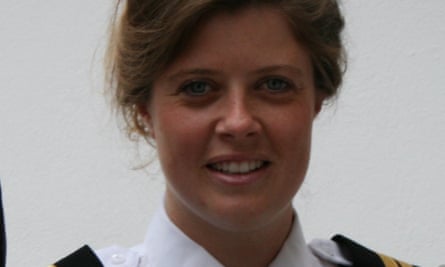
I really enjoyed studying maths and physics and took aerosapce engineering at university. I was looking for a job that wasn’t at a desk, was well-paid and challenging. I did some flying with the air squadron but I was too short to join the RAF, so I went to Jerez in Spain to train for a year and a half and then applied for a job with Jet2 and got on its pilot apprenticeship programme.
Flying is fantastic, it doesn’t feel like a job. You get to see the sun above the clouds and take people on holiday. The training is challenging, you are constantly tested. I fly to more than 50 destinations now, the longest being Tenerife. I particularly enjoy flying into Nice, it’s quite a tricky approach but the views are spectacular along the coast.
Passengers get very excited when they see a woman pilot, especially if they have girls. We need to introduce the idea of flying as a job at an early age, to have role models. I’ve just been to my sister’s school to show them about being a pilot. Generally Jet2 are good at getting out there.
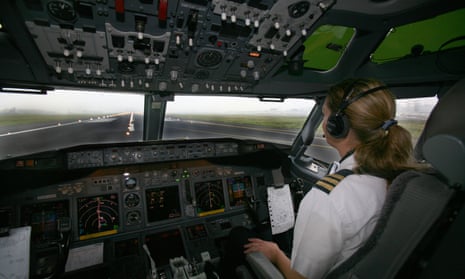
Comments (…)
Sign in or create your Guardian account to join the discussion